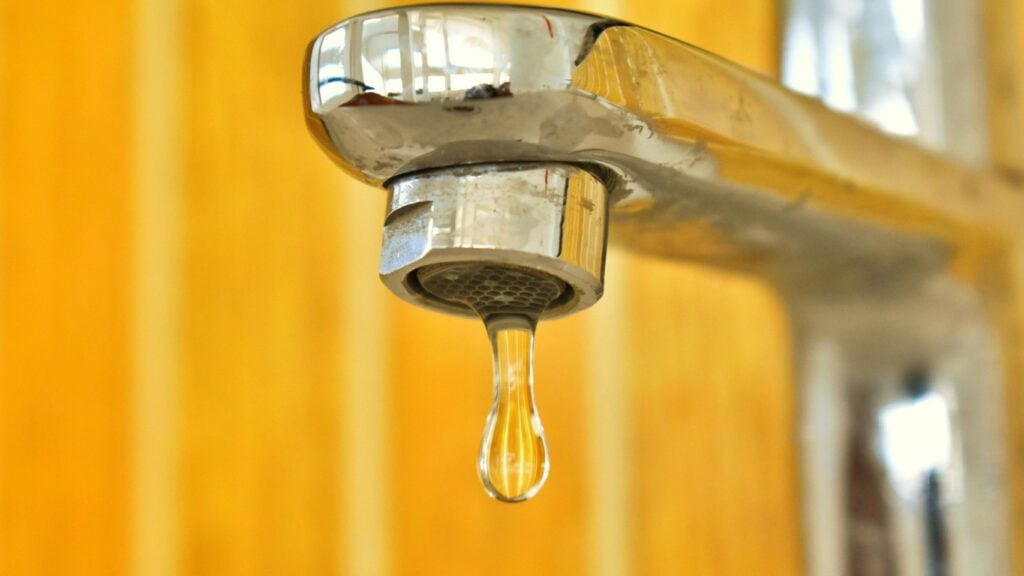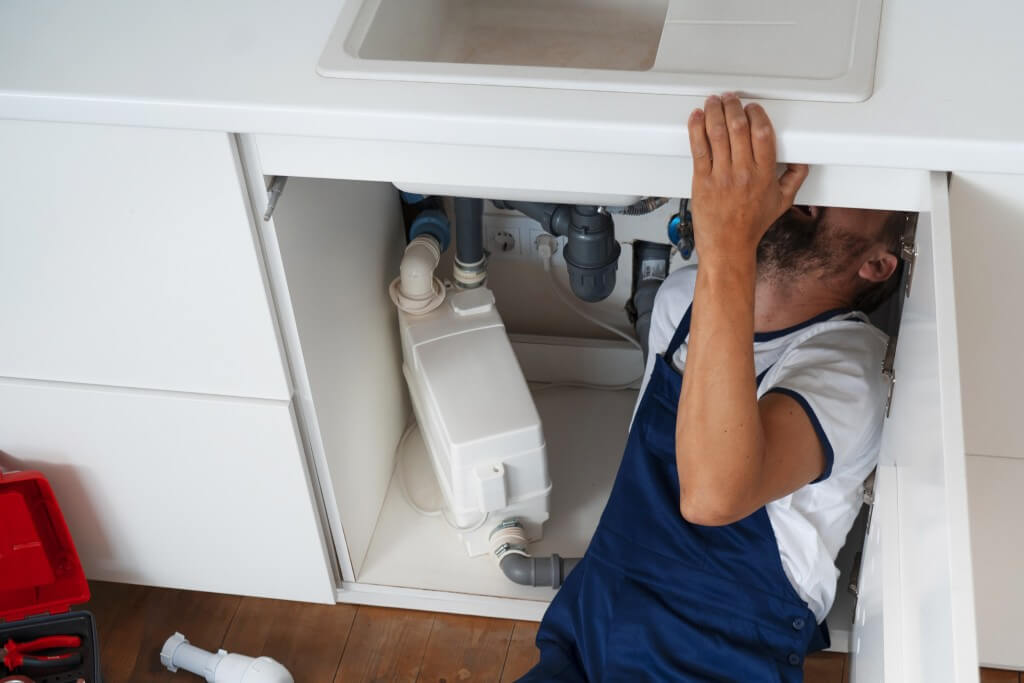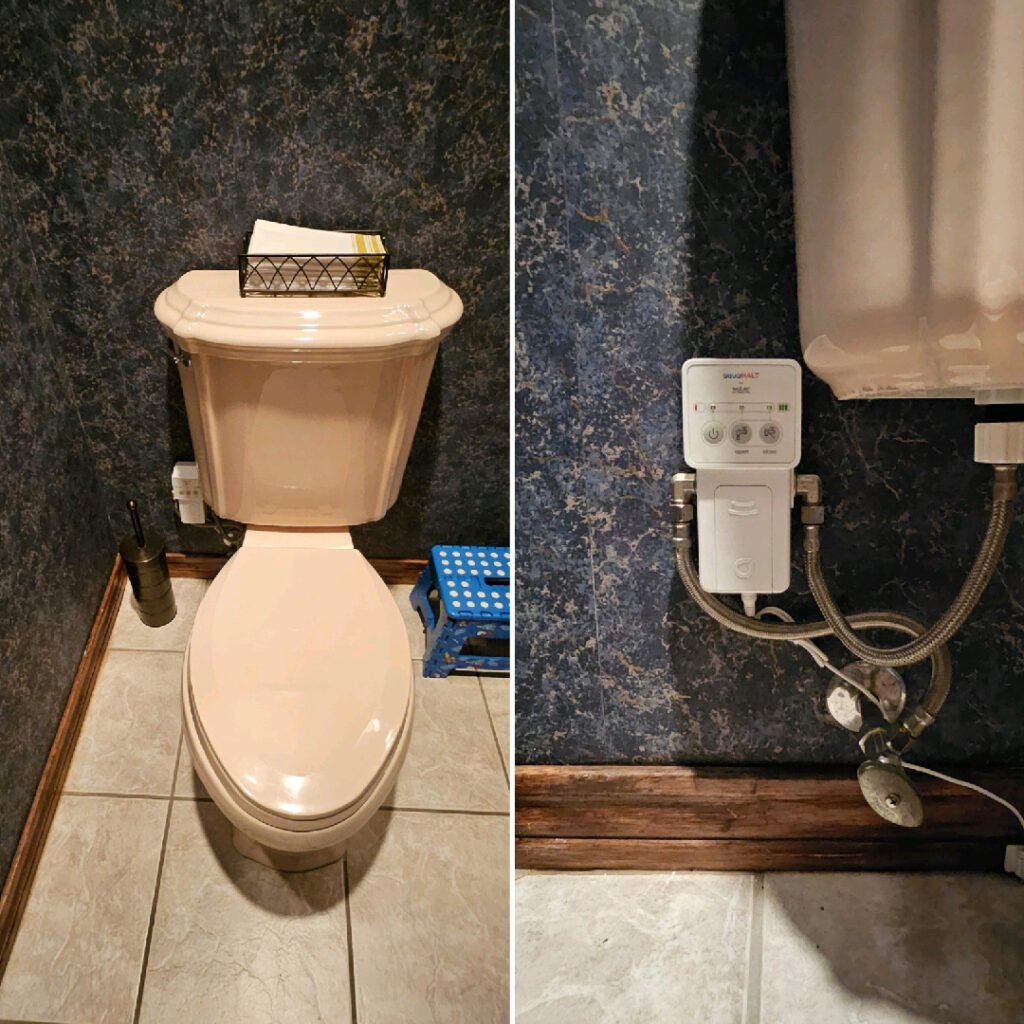
I once walked into a client’s property and saw a single bead of water slowly trace a line down a concrete wall. Just one drop. But it was a red flag—and behind that drop was thousands of dollars in hidden damage. The truth is, water leaks don’t need to be dramatic to be dangerous. Quiet ones—the kind behind walls, under sinks, or I once walked into a client’s property and saw a single bead of water slowly trace a line down a concrete wall. Just one drop. But it was a red flag—and behind that drop was thousands of dollars in hidden damage. The truth is, water leaks don’t need to be dramatic to be dangerous. Quiet ones—the kind behind walls, under sinks, or around windows—are often the most destructive. According to the EPA, household leaks waste nearly 1 trillion gallons of water every year in the U.S. That’s more than 11,000 Olympic-sized swimming pools… literally going down the drain. And yet, most leaks are entirely preventable or easy to fix—if you know how to detect water leaks early.
Start with your water bill. If your usage has spiked but your habits haven’t changed, there’s a good chance water is escaping somewhere it shouldn’t. Next, conduct a simple meter test:
This quick test is one of the most reliable ways to detect water leaks that may not be visible.
Certain areas are notorious for leaks. Here’s where to look:
Also: ceilings. Stains, bubbling paint, or cracks are not just cosmetic problems—they’re warning signs. Regular checks in these areas help you detect water leaks before they turn into expensive repairs.
You don’t always need a plumber. Here are fast fixes you can often do yourself:
But—and this is critical—don’t delay. A $5 part today can prevent a $5,000 repair tomorrow.
An ounce of prevention really is worth a gallon of cure. Add these to your routine maintenance:
Smart sensors that detect water leaks in real time are worth every cent, especially in properties with vulnerable areas or aging infrastructure.
Water leaks are sneaky. But they’re not smarter than you. With the right tools, a sharp eye, and regular maintenance, you can stay one step ahead. I’ve seen what happens when people ignore that first drip. And I’ve seen how much easier life is when they don’t.
Want help building a leak prevention checklist for your home or facility? Reach out. Let’s keep the water where it belongs.
Hidden plumbing leaks are one of the costliest threats to American homes. According to the Insurance Information Institute, water damage accounts for nearly 24% of all home insurance claims in the US, with average repair costs ranging from $3,000–$10,000. The culprit? Not always burst pipes — often, it’s leaks buried in slabs, floors, or behind walls that go unnoticed for months.
Below are the 10 most overlooked plumbing lines that can silently destroy property — and how smart detection tools like aquaHALT can help you stay ahead.
Why they leak: Corrosion or pressure buildup over time.
Risk: Hard to spot since pipes are embedded under tile or concrete.
Monitoring Tip: Use moisture sensors along baseboards near heated areas; install shut-off devices that respond instantly when leaks start.
Why they leak: Movement in foundations or aging copper lines.
Monitoring Tip: Look for warm spots on the floor or unexplained spikes in water bills. Pair these with an aquaHALT shut-off system to stop water flow automatically when abnormal patterns occur.
Often small and plastic, these lines crack or disconnect easily. A slow drip can rot cabinetry or floors within weeks.
Prevention: Add a leak detector like aquaHALT ICE, designed for ice-maker fittings under sinks or behind fridges.
These operate under constant pressure and can burst.
Tip: Replace every 5 years and use sensors near connections.
Visit aquaHALT H/C – Sink Protection to find the right device for your need.
When partially blocked or frozen, they can backflow and flood basements.
Monitor: Regularly inspect outdoor discharge points and use moisture sensors near the sump area.
Common in humid regions like the Southeast US.
Why it matters: Clogged drain pans overflow, damaging drywall.
Prevention: Annual maintenance plus under-unit leak detection.
Cracks from winter freezes are common.
Regional Tip: In colder states (e.g., Minnesota, Michigan), disconnect hoses before winter and insulate bibs.
Small, flexible tubes can leak unnoticed in basements or utility rooms.
Tip: Place a sensor under each connection and test monthly.
Leaks here travel behind walls.
Detection: Install small floor-level sensors in adjacent rooms, especially on upper floors.
A notorious culprit for overnight flooding.
Solution: The aquaHALT 2X or Flip models automatically detect leaks and shut off the water before overflow occurs.
A family in Dallas, TX discovered a slab leak only after noticing a $200 jump in their water bill. Repairs required concrete cutting and floor replacement — costing over $7,500. A $165 or less shut-off device could have prevented 95% of that damage.
Item | Average Cost | Preventable With |
|---|---|---|
Slab Leak Repair | $3,000–$7,500 | Flow-based shut-off valve |
Radiant Floor Repair | $1,200–$5,000 | Sensor + shut-off combo |
Ice Maker Leak Damage | $2,000–$4,500 |
Identify all water lines running under floors or behind walls.
Install smart leak sensors at low points (e.g., baseboards, near valves).
Test your system monthly.
Pair with aquaHALT shut-off valves for automatic protection.
Review data via app or indicator lights to ensure coverage.
Hidden leaks can strike any home — but you can prevent costly disasters before they start.
Equip your home with aquaHALT protection today and gain peace of mind knowing your plumbing system is monitored 24/7.

Hidden leaks are like the ninjas of home damage – silent, sneaky, and devastating. While you’re living your best life, they’re slowly waging war on your walls, floors, and savings.
You won’t hear them. You won’t see them. But one day, you’ll smell them. That’s usually the mold, announcing its victory.
It’s not dramatic to say that hidden leaks are one of the most expensive home problems that no one talks about – until it’s too late.
Water is a professional escape artist. Once it finds a weak point – a loose connection, a cracked seal, or a tiny pinhole in a pipe – it escapes quietly into places you can’t reach.
It travels along beams and insulation, soaking everything along the way. And because it’s hidden, you don’t notice it until:
By then, the damage isn’t just cosmetic – it’s structural.
If hidden leaks are the ninjas, mold is their evil sidekick. Once moisture lingers for more than 24–48 hours, mold spores throw a party.
They spread fast, latch onto porous materials, and start producing that lovely “damp basement” smell that every homeowner dreads.
And while it might start small, mold cleanup is no joke. Depending on how far it’s spread, mold remediation can cost anywhere from $1,200 to over $6,000 – not counting the damage it’s caused along the way.
Some homeowners spend months dealing with cleanup crews, insurance adjusters, and the emotional trauma of tossing out their favorite furniture. All because of one tiny leak.
Let’s put this into perspective:
Problem | Average Cost | Avoidable With Early Detection? |
|---|---|---|
Replacing water-damaged flooring | $2,500–$5,000 | ✅ Yes |
Mold remediation | $1,200–$6,000 | ✅ Yes |
Structural repair from rot | $5,000+ | ✅ Yes |
Water damage insurance claim | $11,000 average | ✅ Yes |
So when you compare that to the $150 price tag of aquaHALT, the math starts to make sense – prevention is the ultimate money-saver.
Some of the most common culprits for hidden leaks include:
Water doesn’t need an open tap to do damage – a single, tiny crack under pressure can release liters a day.
And the scary part? You won’t notice a thing until you step onto a warped floorboard or spot that telltale stain spreading across the ceiling.
Early detection isn’t just about saving money – it’s about keeping your home livable and your stress levels low.
When a hidden leak goes undetected, you’re in for:
Catching the leak early means you avoid all that. No stress, no surprises, no soggy carpets.
Now, imagine if your home had a tiny, tireless guardian that could hear trouble before it struck. That’s aquaHALT, created by waterAUTOMATION.
For just $150, you get a battery-powered leak detection device that works 24/7 – even during power cuts. It runs on 2×AA batteries, installs in seconds, and doesn’t need Wi-Fi, an app, or your Saturday afternoon.
Just place it near problem areas – under sinks, behind appliances, near your water heater – and it immediately starts listening for leaks.
When water appears where it shouldn’t, aquaHALT sounds the alarm before you’re knee-deep in trouble.
We live in an age where everything’s “smart.” But do you really need a leak detector that connects to the cloud, syncs with your toaster, and asks for monthly updates?
No. You just need something that works – reliably, quietly, and immediately.
That’s why aquaHALT’s simplicity is its superpower. It doesn’t rely on Wi-Fi or fancy integrations. It just protects your home, day and night, for pennies a day.
It’s like having a loyal guard dog for your plumbing system – minus the barking.
You don’t need to wait for mold, warped floors, or a swollen water bill to take action.
Preventing water damage isn’t rocket science – it’s awareness, preparation, and a little help from the right device.
So, before water sneaks up on you, sneak up on it.
Install aquaHALT once, sleep better forever.

Let’s be honest – home disasters don’t usually knock first. They kick the door down. One minute you’re watching TV, the next your laundry room looks like a kiddie pool.
Water leaks are sneaky like that. They strike when you’re least prepared – on holidays, overnight, or that one weekend you actually decided to relax.
But what if one small, $150 device could stop all of that before it even began?
Meet aquaHALT, the tiny hero by waterAUTOMATION that quietly stands guard while you’re out living your life.
In a world where everything needs charging, updating, and syncing, aquaHALT is refreshingly simple. It doesn’t need Wi-Fi, a smartphone app, or a 43-step setup process.
It runs on two AA batteries – that’s it. Pop them in, place the device where water might cause trouble (under your sink, behind your washing machine, near the water heater), and you’re done.
No monthly subscriptions. No pairing codes. No software updates at 2 a.m. Just old-fashioned reliability in a smart little package.
Sure, “smart home” leak detectors sound cool – until your Wi-Fi goes down, your app glitches, or your phone dies.
aquaHALT doesn’t care about Wi-Fi signals or firmware updates. It’s too busy doing its job:
listening 24/7 for the faintest sign of water where it doesn’t belong.
And when it finds one? It lets you know – immediately. Loudly.
Because the only thing worse than a leak is not knowing you have one.
At first glance, aquaHALT doesn’t look like much – just a compact device powered by two humble batteries. But under the hood, it’s a powerhouse of prevention.
Its high-sensitivity water sensors can detect even small amounts of moisture before they turn into major problems.
That means no more waking up to soggy carpets, dripping ceilings, or that dreaded “splash” sound when you step into the laundry room.
In other words, aquaHALT doesn’t wait for disaster – it prevents it.
One of the biggest myths about water damage is that it only happens in older homes.
Wrong.
Even brand-new builds can have leaks – from shifting foundations, loose fittings, or appliances that weren’t installed perfectly. Water doesn’t discriminate.
So whether your house is 30 days old or 30 years old, a leak detector is a must-have.
Think of aquaHALT as an equal-opportunity protector.
Leaks don’t punch time cards. They don’t take weekends off. That’s why aquaHALT never clocks out.
While you’re asleep, at work, or away for the holidays, it’s still watching, still listening, and still ready to sound the alarm if water shows up where it shouldn’t.
It’s like having a personal security guard for your plumbing system – minus the attitude and the coffee breaks.
Installing aquaHALT takes less time than making a cup of coffee:
That’s it. No wiring. No Bluetooth pairing. No instruction manual thicker than a novel.
Just quiet protection you don’t have to think about until it saves you.
It’s the kind of device you forget exists – until the day it saves you a fortune.
Our homes are getting smarter – but sometimes, simple tech wins the day.
aquaHALT is proof that you don’t need Wi-Fi, cloud syncing, or subscription plans to protect what matters.
Just a small device, a little foresight, and two AA batteries.
Leaks don’t care about your schedule, your new floor, or your peace of mind. But aquaHALT does.
For $150, it gives you round-the-clock protection, zero setup headaches, and the priceless satisfaction of outsmarting water itself.
Because the best home upgrades don’t just make life easier – they make it drier.

You’re making coffee, half-awake, when you notice that faint drip… drip… drip under the sink. It’s nothing major, you tell yourself – a few drops, maybe a loose pipe. You’ll fix it on the weekend.
Fast-forward two months. The floorboard’s warped, the cabinet door doesn’t close properly, and there’s a strange smell that Febreze can’t fix. Welcome to the world of water leaks – small, sneaky, and surprisingly destructive.
The thing about leaks is they’re patient. They wait quietly, often behind walls, under floors, or around fittings, while slowly transforming your house into an indoor swamp.
Most homeowners underestimate water. It doesn’t take a flood to cause major damage – just a tiny, persistent drip. Water has one mission: to go where it shouldn’t.
Here’s what that seemingly harmless trickle is really doing while you ignore it:
In fact, according to insurance data, the average household water-damage claim is around $11,000. That’s enough to buy 73 aquaHALT devices – each designed to stop the problem before it even begins.
There’s a fascinating thing about leaks – everyone knows they’re bad, but almost no one acts right away. Why? Because they don’t feel urgent… until they are.
When your roof leaks, you panic. When your pipe bursts, you panic. But when your sink slowly drips, you shrug. The irony? That drip can cause more long-term damage than either of those sudden disasters, because it quietly corrodes materials over time.
So if you’re thinking, “It’s just a few drops,” remember: those “few drops” might be the most expensive ones you ever ignore.
Leaks don’t exactly send invitations – but they do leave clues. Here are the telltale signs your home might be harboring a watery secret:
You haven’t started a backyard water park, but your bill looks like you did. A sudden spike usually means a hidden leak.
That “basement smell” upstairs isn’t normal. Moisture trapped in walls or under floors gives off that earthy, mildew-like odor.
Your walls are literally crying. Moisture trapped behind paint or paper causes bubbles, blisters, or peeling.
When wooden surfaces start bowing or curving, they’re soaking up moisture from somewhere nearby.
If you’ve cleaned it and it returns, that’s not bad luck – it’s a leak feeding it from behind.
Spot these signs early and you’re halfway to saving your home (and your weekend).
We’ve already talked about how leaks destroy materials, but let’s put numbers on the pain:
And that’s not counting the stress, time, and disruption of repairs. You’ll be living with fans, dehumidifiers, and that unforgettable “construction zone chic” aesthetic for weeks.
Compare that to $150 for a leak detection device. The math isn’t hard – but apparently, water loves teaching lessons the expensive way.
Some leaks are easy to see – a dripping faucet, a puddle under the washing machine. Others are experts at hide-and-seek.
They lurk behind drywall, beneath tiles, or inside ceilings, silently destroying things from within. By the time you notice a stain, it’s already been there for weeks.
That’s why early detection isn’t just helpful – it’s everything. The faster you find a leak, the less damage it can do.
Here’s where aquaHALT, the smart (but delightfully simple) leak detection device from waterAUTOMATION, earns its cape.
It doesn’t need Wi-Fi, Bluetooth, or a PhD in smart-home setup. It runs on 2×AA batteries and sits quietly under sinks, near washing machines, or behind your fridge – always listening, always ready.
When it senses even the smallest presence of water, it sounds the alarm before the damage starts. No complicated installation. No monthly fees. Just good, old-fashioned peace of mind wrapped in clever engineering.
Water doesn’t respect schedules – it leaks on Sundays, holidays, and when you’re away on vacation. That’s why aquaHALT never clocks out.
For less than what you’d spend on a dinner date, you get 24/7 protection that saves you from the world’s worst wake-up call: the sound of splashing where there shouldn’t be any.
Two AA batteries. One smart idea. Zero panic.
Let’s be real – no one brags about installing a leak detector. But everyone wishes they had one after the damage is done.
You don’t need to wait for a leak to ruin your day, your walls, or your savings account. Catch it early. Stop it fast. Sleep better.
That’s what aquaHALT does – quietly, constantly, and for just $150.
Because peace of mind shouldn’t cost thousands.